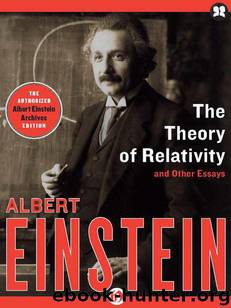The Theory of Relativity: And Other Essays by Albert Einstein

Author:Albert Einstein [Einstein, Albert]
Language: eng
Format: epub
Tags: nepalifiction, TPB
ISBN: 9781453204733
Amazon: 1453204733
Publisher: Open Road
Published: 2011-03-15T04:00:00+00:00
Quantum Theory and the Fundamentals of Physics
The theoretical physicists of our generation are expecting the erection of a new theoretical basis for physics which would make use of fundamental concepts greatly different from those of the field theory considered up to now. The reason is that it has been found necessary to use—for the mathematical representation of the so-called quantum phenomena—new sorts of methods of consideration.
While the failure of classical mechanics, as revealed by the theory of relativity, is connected with the finite speed of light (its avoidance of being ∞), it was discovered at the beginning of our century that there were other kinds of inconsistencies between deductions from mechanics and experimental facts, which inconsistencies are connected with the finite magnitude (the avoidance of being zero) of Planck's constant h. In particular, while molecular mechanics requires that both, heat content and (monochromatic) radiation density, of solid bodies should decrease in proportion to the decreasing absolute temperature, experience has shown that they decrease much more rapidly than the absolute temperature. For a theoretical explanation of this behavior it was necessary to assume that the energy of a mechanical system cannot assume any sort of value, but only certain discrete values whose mathematical expressions were always dependent upon Planck's constant h. Moreover, this conception was essential for the theory of the atom (Bohr's theory). For the transitions of these states into one another—with or without emission or absorption of radiation—no causal laws could be given, but only statistical ones; and, a similar conclusion holds for the radioactive decomposition of atoms, which decomposition was carefully investigated about the same time. For more than two decades physicists tried vainly to find a uniform interpretation of this “quantum character” of systems and phenomena. Such an attempt was successful about ten years ago, through the agency of two entirely different theoretical methods of attack. We owe one of these to Heisenberg and Dirac, and the other to de Broglie and Schrödinger. The mathematical equivalence of the two methods was soon recognized by Schrödinger. I shall try here to sketch the line of thought of de Broglie and Schrödinger, which lies closer to the physicist's method of thinking, and shall accompany the description with certain general considerations.
The question is first: How can one assign a discrete succession of energy value Hσ to a system specified in the sense of classical mechanics (the energy function is a given function of the coordinates qr and the corresponding momenta pr)? Planck's constant h relates the frequency to the energy values It is therefore sufficient to give to the system a succession of discrete frequency values. This reminds us of the fact that in acoustics, a series of discrete frequency values is coordinated to a linear partial differential equation (if boundary values are given) namely the sinusoidal periodic solutions. In corresponding manner, Schrödinger set himself the task of coordinating a partial differential equation for a scalar function to the given energy function where the qr and the time t are independent variables.
Download
This site does not store any files on its server. We only index and link to content provided by other sites. Please contact the content providers to delete copyright contents if any and email us, we'll remove relevant links or contents immediately.
The Complete Stick Figure Physics Tutorials by Allen Sarah(7339)
Secrets of Antigravity Propulsion: Tesla, UFOs, and Classified Aerospace Technology by Ph.D. Paul A. Laviolette(5338)
Thing Explainer by Randall Munroe(3911)
The River of Consciousness by Oliver Sacks(3574)
The Order of Time by Carlo Rovelli(3164)
How To by Randall Munroe(3078)
A Brief History of Time by Stephen Hawking(2994)
I Live in the Future & Here's How It Works by Nick Bilton(2963)
What If?: Serious Scientific Answers to Absurd Hypothetical Questions by Randall Munroe(2670)
The Great Unknown by Marcus du Sautoy(2666)
Midnight in Chernobyl by Adam Higginbotham(2520)
Blockchain: Ultimate Step By Step Guide To Understanding Blockchain Technology, Bitcoin Creation, and the future of Money (Novice to Expert) by Keizer Söze(2467)
Networks: An Introduction by Newman Mark(2383)
The Meaning of it All by Richard Feynman(2320)
Easy Electronics by Charles Platt(2310)
The Tao of Physics by Fritjof Capra(2247)
Midnight in Chernobyl: The Untold Story of the World's Greatest Nuclear Disaster by Adam Higginbotham(2200)
Introducing Relativity by Bruce Bassett(2098)
When by Daniel H Pink(2098)
